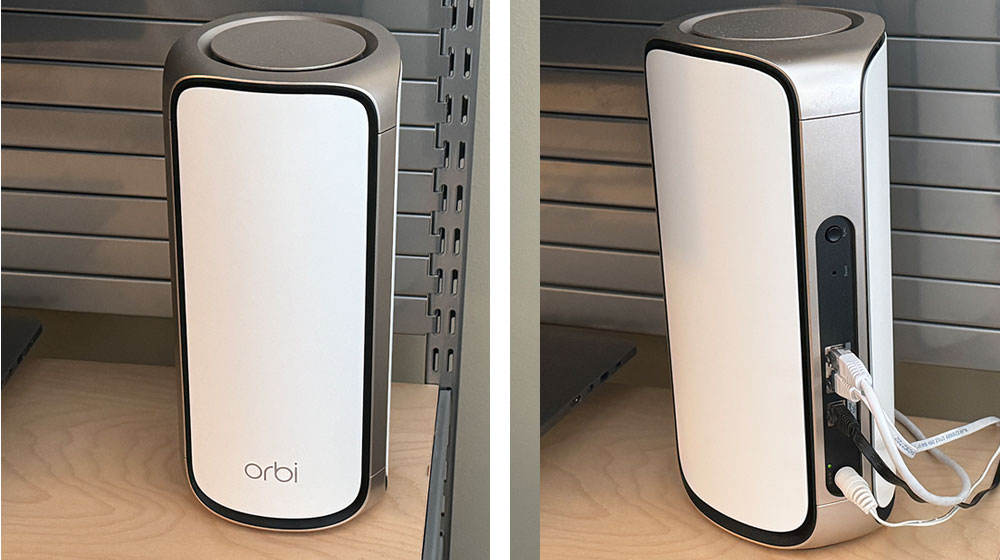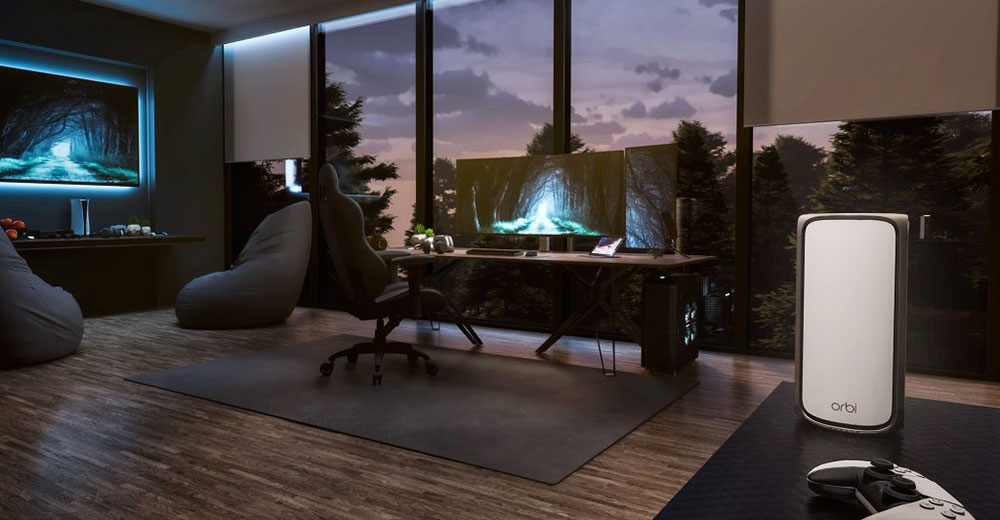Despite all the hoopla around 5G over the past few years, Wi-Fi technology remains essential for keeping people connected.
Wi-Fi 7 can potentially be a game-changer in the future, offering previously unheard-of levels of speed, dependability, and efficiency.
My 30-day experience with the new Orbi RBE973 Mesh Router, the three-pack from the 970 series, validates the reasons that make Wi-Fi 7 so exciting and how it could completely transform how we connect and interact.
Orbi RBE973, Netgear’s first Wi-Fi 7 mesh networking kit, astounded me in ways that I did not anticipate based on prior experiences with routers — Orbi’s previous and highly regarded Wi-Fi 6 and 6E routers.
With features like 6GHz integration, ultra-wide data channels, quad-band design, and 4K QAM operations, the Orbi RBE973 router and two mesh nodes offer the newest wireless LAN technology. The company also sells single units and two bundles, though pricing is not for the squeamish (more on that later).
High-speed networking that approaches 2 Gbps is the outcome. Indeed, its lightning-fast data transfer speeds can make traditional gigabit wired Ethernet appear sluggish, making it ideal for users with fast internet connections.
The Orbi RBE973 mesh kit is the best option for a small- or mid-sized house since, despite being the quickest at close range, it lags at large distances, which is disappointing.
In terms of Netgear’s extensive 90-day support policy and one-year guarantee, it is mediocre. Considering that an Orbi RBE973 three-pack costs $2,300, dramatically higher than the priciest Wi-Fi 7 router currently on the market, that pricing could be regarded as highway robbery.
Standout Specs of the Orbi RBE973 Router
The quad-band architecture of the Orbi RBE973 allows it to transport 16 separate data streams with a 4×4 data flow. Its 12 amplified isotropic antennas produce its spherical transmission pattern, which has an equal range in all directions. The RBE970 family’s communications from the satellites to the host router occur over a dedicated 5GHz wireless backhaul channel.
The router optimizes the flow using some 6GHz bands when necessary. There’s a catch, though: the 6GHz backhaul can fit in more data by using a proprietary 240MHz data delivery mechanism instead of the anticipated 160MHz data channels.

The Orbi RBE970 series can employ a 10 Gbps wired connection for backhaul using a Cat 6 or higher cable for optimal performance. (Photo by Author)
On the downside, the Orbi RBE973 itself has nothing to do with the main obstacle preventing Wi-Fi 7. The reality is that there are still few options available for client hardware that can take advantage of the performance possibilities offered by the new Wi-Fi specification.
During my three-week study period, I utilized a OnePlus 11 supplied to me by Netgear, and while it had a minor speed disadvantage, it functioned well with Wi-Fi 7 equipment.
Unfortunately, Wi-Fi 7 notebooks may not be available until late 2024, when the major PC OEMs refresh their laptop lineups for the holidays.
The Orbi RBE973 proved just as remarkable at a real-world distance of 15 feet. Data hogs should be cheered by this.
Wi-Fi Performance Comparison
For comparison’s sake and to demonstrate Wi-Fi 6E compatibility, my iPhone 15 Pro Max was 15 feet from the Orbi RBE973 router and received 1.5476 Gbps of data. Although it’s a step back, the outcome is still sensational, considering the hardware is one generation behind Wi-Fi 7. Here’s a breakdown of my informal speed benchmark testing versus Netgear’s RBEK960E (Wi-Fi 6E) router, which I’ve been using for the past year:
| SHORT RANGE (5 Feet) | LONG RANGE (30 Feet) | |||
|---|---|---|---|---|
| Router Throughput 5GHz Band |
Satellite Throughput 5GHz Band |
Router Throughput 5GHz Band |
Satellite Throughput 5GHz Band |
|
| Netgear Orbi RBE973S (Wi-Fi 7) |
974 Mbps | 1,052 Mbps | 2,225 Mbps | 1,453 Mbps |
| Netgear Orbi RBE 960E (Wi-Fi 6E) |
902 Mbps | 751 Mbps | 1,100 Mbps | 890 Mbps |
My informal network saturation test, in which I streamed the CNN news feed on an iPad Pro, played movies on my new MacBook Pro and played several Netflix movies on a Dell XPS laptop, had no issues. That’s a reasonably onerous stress test, but the audio or video had no hiccups or freezes.
The heat never rose above 94 degrees Fahrenheit on the Orbi RBRE973 devices. However, they felt warm to the touch. There is no power-saving idle option; the host router consumes about 20 watts during operation, while the satellite nodes use approximately 11 watts each.
Assuming you pay the U.S. national average of 16 cents per kilowatt hour for electricity, that comes to a $60 annual power bill. Depending on where you live, $60 is a modest price to pay for such a well-performing router.
Final Thoughts
Orbi’s new RBE973 is the first router I’ve used that has come close to, and in some cases fulfilled, the promise of providing tethered-like wireless performance.
Netgear indicates that its new Orbi 970 Series mesh system (three-pack) supports 200 connected devices — an unimaginable number, in my opinion, for even the most ardent consumer techie — and covers 10,000 square feet, 10% more than the 960 Series.
Satellites can be installed to increase coverage. Each Orbi 970 add-on satellite covers up to 3,300 square feet and features one 10GB and two 2.5GB Ethernet connections to unlock heightened performance and dependability on more connected devices, making true multi-gig Wi-Fi possible. However, most consumers do not take advantage of it.
However, in this instance, it gives me hope that the maximum performance that the Wi-Fi 7 protocol could muster was well worth the wait, and the fastest mesh kit on the market right now is Netgear’s Orbi RBE973.
In addition to supporting 4K QAM modulation, 6GHz transmissions, and 320MHz data channels, it also takes full advantage of these novel approaches to transfer more data. It is the first to surpass the 2 Gbps barrier, the wireless equivalent of putting a man on the moon.
Orbi RBE973: Key Takeaways
- Revolutionary performance achieves near-tethered wireless speeds
- Extensive coverage supports 200 devices and covers 10,000 square feet
- Advanced connectivity featuring multi-gig Wi-Fi capabilities through additional satellites
- Breakthrough in speed: first to exceed 2 Gbps, setting a new benchmark in wireless technology
- Excellent security overshadowed by limited warranty and tech support period, given the product’s high cost
- Ideal use case: small- to medium-sized living spaces and home offices despite extensive coverage potential
- Premium pricing: high cost but unparalleled performance for those who invest
In light of this, the Orbi RBE973 offers a great range of inputs, especially for those with fast data connections. Although its Armor layer of security is among the finest at keeping a network safe and secure in a world where malware is rampant, the company’s warranty and support duration — especially given the Porsche-like price point — is incredibly disappointing, and the warranty coverage only lasts a year.
Though far from flawless, its short-range performance within the same room or just next door is mind-blowing.
Home users in an average-sized house typically operate their laptops, smartphones, or tablets within 20 feet of the router or add-on satellite, so that shouldn’t be a showstopper for most folks. Therefore, it is more suitable for a modestly sized house or apartment than a large one, though the Orbi satellites will technically provide 10,000 square feet of coverage.
The $2,300 price tag of the Orbi RBE973 is unabashedly high, but if you can swing that, you won’t be disappointed.























































